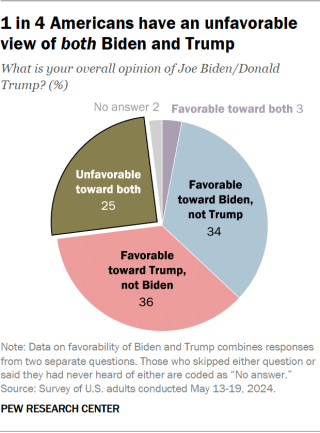
With the 2024 U.S. presidential election about five months away, a quarter of Americans hold unfavorable views of both major party candidates – President Joe Biden and former President Donald Trump. This is according to a Pew Research Center survey of 8,638 adults conducted May 13-19.
We conducted this analysis to explore how Americans’ views of the 2024 major party presidential candidates compare to views of past candidates.
Candidate favorability ratings are based on Pew Research Center surveys and the archives of the Roper Center for Public Opinion Research, using surveys conducted in May or June of each election year.
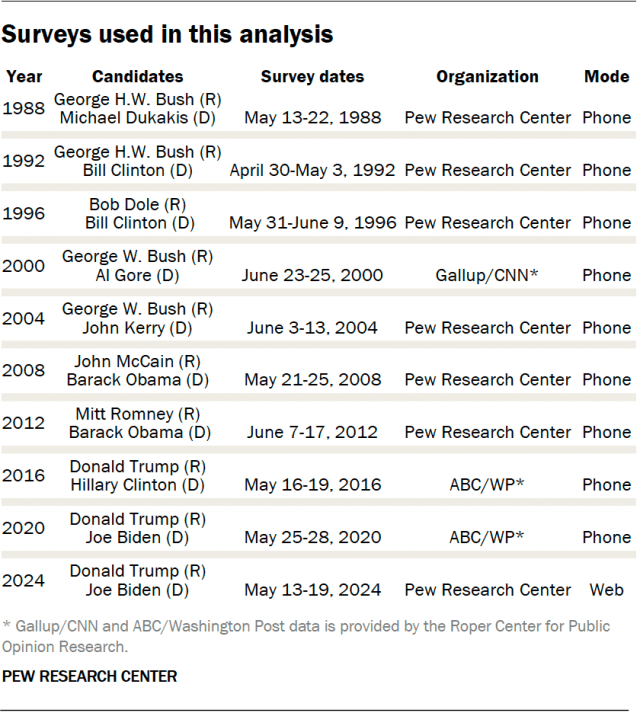
The 2024 data in this analysis is based on a survey of 8,638 adults conducted from May 13 to 19, 2024. The survey was conducted on the Center’s nationally representative American Trends Panel (ATP), an online survey panel that is recruited through national, random sampling of residential addresses. This way nearly all U.S. adults have a chance of selection. Read more about the ATP’s methodology.
The survey is weighted to be representative of the U.S. adult population by gender, race, ethnicity, partisan affiliation, education and other categories. Here are the questions used for this analysis, along with responses.
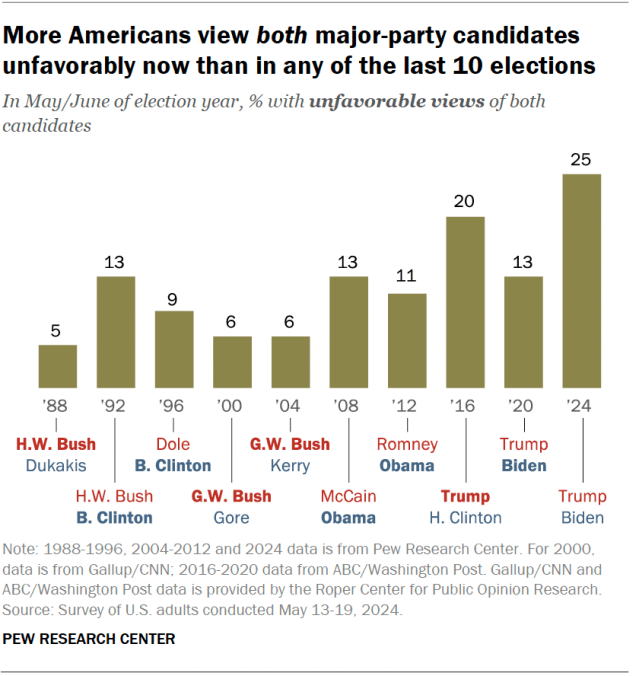
That is the highest share expressing negative views of both candidates in surveys conducted at about this point in the election cycle by the Center and other organizations dating back to the 1988 election. And it’s nearly twice as high as four years ago, when 13% of Americans expressed unfavorable opinions of both Biden and Trump.
(The 2024 Center survey was conducted before Trump’s conviction on 34 criminal counts in the New York “hush money” case on May 30.)
The previous high point for negative views of both presidential candidates was in 2016. At about this point in the 2016 campaign, 20% of Americans expressed unfavorable opinions about both Hillary Clinton and Donald Trump.
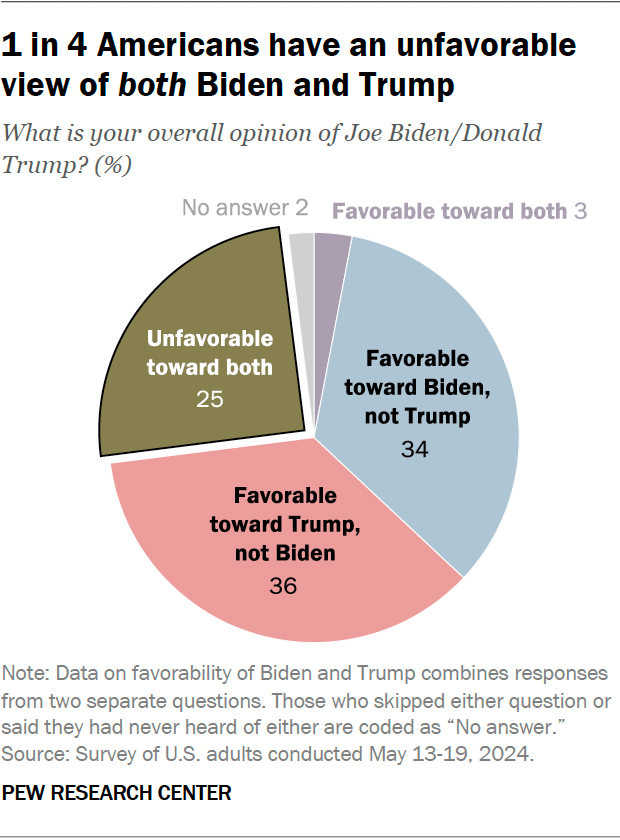
Prior to 2016, no more than about one-in-ten Americans had held unfavorable opinions of both major party candidates at this stage of any of the seven previous presidential campaigns. And during several campaigns – most recently George W. Bush versus John Kerry in 2004 – no more than about 5% did.
In the current campaign:
- Slightly more than a third of Americans (36%) have a favorable view of Trump and an unfavorable opinion of Biden.
- Nearly as many (34%) have a favorable view of Biden and a negative one of Trump.
- 25% have unfavorable views of both candidates, while just 3% feel favorably toward both.
Americans’ opinions of Biden and Trump are largely unchanged since March.
Favorability of major party presidential candidates, 1988-2024
According to the 2024 survey, 39% of Americans view Trump favorably, while 37% have a positive opinion of Biden. Trump’s ratings are roughly the same as they were at about the same point in 2016 (37% favorable) but lower than in 2020 (42%). Biden’s ratings are lower than they were at this point in 2020 (46% favorable).
Overall, the favorability ratings for major party presidential candidates during the past three elections have been lower than in prior elections.
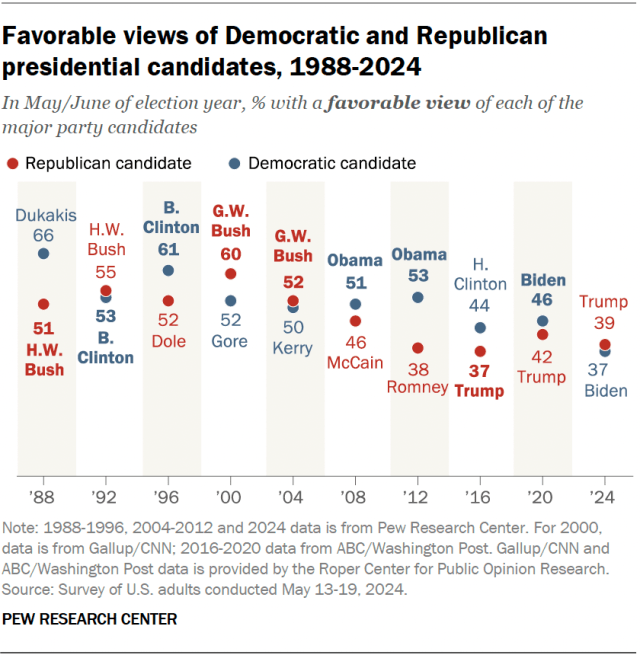
At this point in the last three election cycles, each of the major party candidates – Clinton and Trump in 2016, and Biden and Trump in 2020 and 2024 – have had favorable ratings below 50%.
In contrast, in every election between 1988 and 2012, at least one candidate had a favorable rating of at least 50% at about this point. In 2004 and earlier, both candidates had ratings of at least 50%.
Three candidates during this period had favorable ratings at or above 60%: Michael Dukakis in 1988, Bill Clinton in 1996 and George W. Bush in 2000. Clinton’s and Bush’s ratings remained at about that level for the remainder of the campaign, while ratings for Dukakis declined.
Increasing partisanship in views of presidential candidates
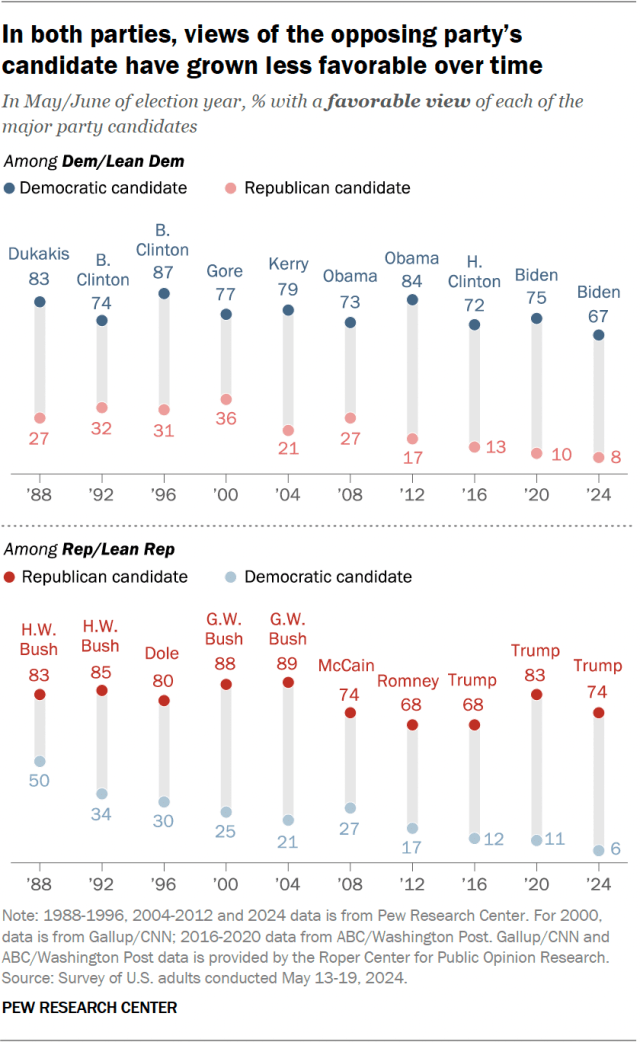
Increasing negative partisanship is a major factor behind the decline in favorability of major party candidates.
In that regard, the pattern is similar to the growing partisanship in presidential job approval ratings.
Favorability ratings for candidates have become considerably more negative among members of the opposing party than they were a few decades ago.
Just 8% of Democrats and Democratic-leaning independents have a favorable opinion of Trump. A similar share of Republicans and Republican leaners (6%) feel positively toward Biden.
In contrast, as recently as 2008, 27% of Democrats viewed Republican candidate John McCain favorably while an identical share of Republicans had a favorable opinion of Democratic candidate Barack Obama.
Favorability of leaders in both parties
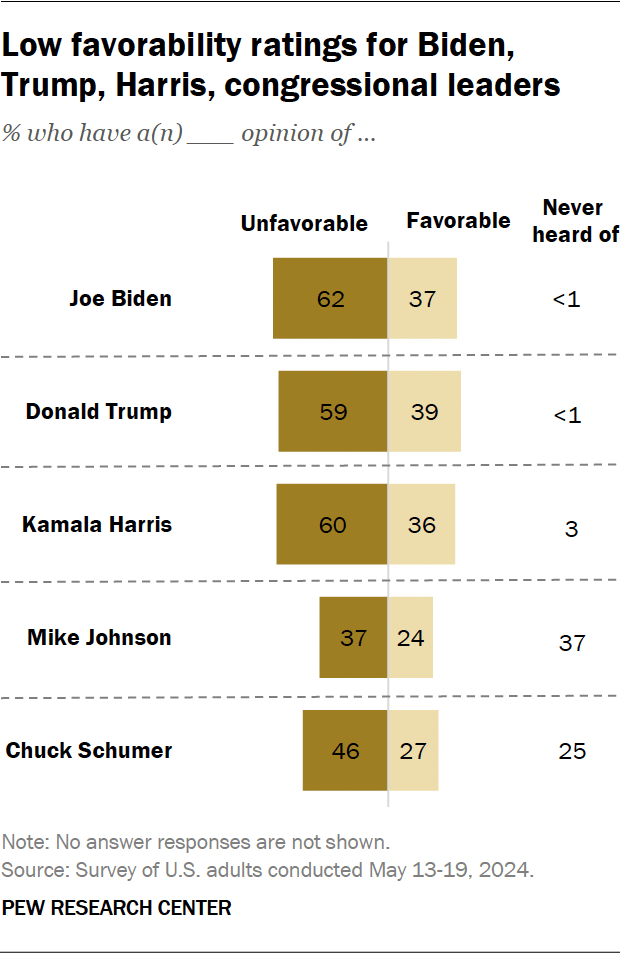
Americans’ negative evaluations of political leaders also extend to the leadership of both chambers of Congress and the vice president.
Six-in-ten hold unfavorable views of Vice President Kamala Harris, while 36% rate her favorably. Another 3% say they have not heard of her. These ratings are essentially unchanged since July 2023.
Americans are much more likely not to have heard of Republican House Speaker Mike Johnson (37%) or Democratic Senate Majority Leader Chuck Schumer (25%).
Still, those who have heard of them view both congressional leaders more unfavorably than favorably. Schumer’s rating is largely unchanged in recent years. This is the first time the Center has asked about Johnson.
Note: Here are the questions used for this analysis, along with responses.
